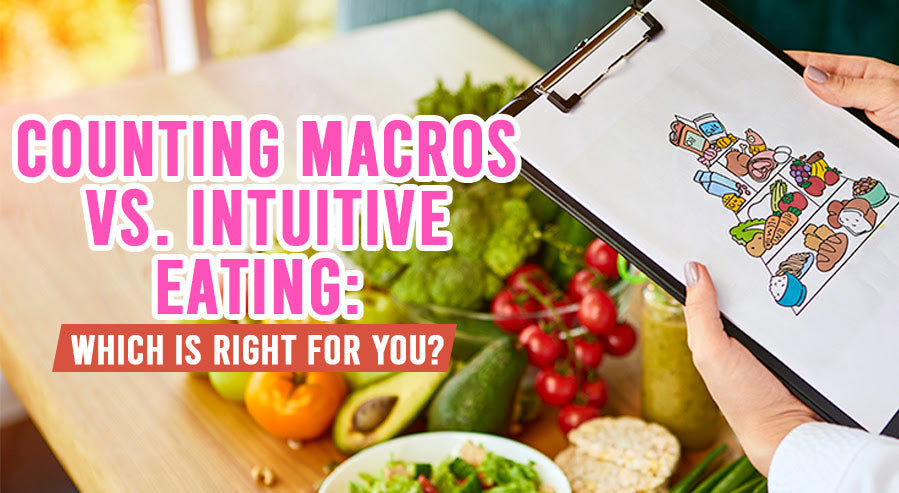Counting Macros vs. Intuitive Eating: Which is Right For You?

A well-balanced nutrition strategy can help you to take better care of your health and fitness. Macro counting can give you more precise control over your food intake, and intuitive eating can help create a natural relationship with food.
The best strategy will depend on your personal goals and your lifestyle. These strategies can change how you see eating and wellness.
I'll look at three areas that matter - flexibility, control, and sustainability. You should examine your schedule, your mental health, and your long-term goals as we compare these methods. This process can help you find out what will work best for you.
Let's get started!
Macro Tracking Definition And Basics
Macro tracking is a way for you to tabs on the three big nutrients in your food - proteins, carbohydrates, and fats! These three nutrients work together as the building blocks that help to power your body throughout the day.
Your body needs each of these nutrients for different reasons. You need protein to build strong muscles and recover from workouts, which is why fitness enthusiasts always tell you about their protein shakes. Carbs work like fuel for your body, and they give you the energy for your activities.
Fats also play a job by helping your body soak up vitamins and keeping your brain sharp. Smartphone apps can make macro tracking easy. These apps do most of the heavy lifting for you, and you just input what you eat.
Popular apps often come with barcode scanners, which makes it easier to log packaged foods. The real challenge with macro tracking sometimes comes from overthinking it. You might find yourself spending too much time reading food labels or obsessing over your food scale.
![]()
Some people give up because it starts feeling like a boring job. A secret about macro tracking that not everyone mentions is that you don't need to hit your numbers well every single day. Life goes on if you shoot for 150 grams of protein but only reach 140.
Some days, you'll hit your targets, and other days, you'll miss them completely. That's how it goes sometimes. Top athletes use macro tracking to fine-tune their nutrition so they can reach peak performance.
Marathon runners load up on carbs before races, and bodybuilders have enough protein. Regular people can also track macros if they want to drop some pounds or build more muscle. You can fit pizza and ice cream into your tracking.
You'll see how these foods fit into a nutrition plan when you also manage a budget for your macros. You'll need some practice to get better at macro tracking, just like with any new skill. Most people need a few weeks to get into the groove of it. You'll probably forget to log some meals or miscalculate your portion sizes now and then. These learning moments are all just part of figuring it out.
Major Benefits Of Macro Tracking
You can track your macros even though it might feel a bit stressful at times. When you break down your meals into proteins, carbs, and fats, it'll give you a clear path to better eating habits. These basic building blocks of nutrition can make your food options easier to manage, too.
You won't know if you're eating enough protein for muscle growth without tracking your food and meals. When you count your macros, it takes out the guessing from your meal planning. You'll quickly find out how much chicken breast or protein powder you might need to eat each day.
Most people see big changes in their bodies within the first few months of macro tracking. Your strength might increase faster at the gym when you nail your protein goals.
![]()
If you plan your meals ahead of time based on your macro targets, it makes sticking to a weight loss plan feel much easier to manage. When you meet your macro goals, there are rewards to try (and they're worth it). You'll start to find portion sizes without needing to pull out your food scale every single time.
You'll soon be able to look at a part of salmon and know it has 30 grams of protein without second-guessing. Macro tracking will teach you about how different types of foods can affect your energy levels and health. Your workouts could feel better when you eat enough carbs, and you might sleep more peacefully with enough healthy fats in your evening meal.
Your success with macro tracking will depend on how well you log your meals. A user-friendly tracking app can help in this process, so you won't have to waste time crunching numbers every time you sit down to eat.
The mental rewards from macro tracking are the physical ones. Your relationship with food might change as you stop labeling foods as forbidden or allowed. You'll view each meal as a chance to hit your macro goals, which helps you have a healthier mindset with eating.
Typical Drawbacks Of Macro Tracking
You can burn yourself out by tracking every single bite of food that you eat. People can spend hours each day logging their meals and crunching the numbers. This turns their eating habits into a stressful math problem. The non-stop pressure to hit the targets can take the joy out of eating.
Restaurant meals can become a challenge when you're counting your macros, too. You might find yourself turning down some spontaneous dinner invites just because you can't measure the ingredients. Restaurant meals will throw off your planned numbers and make you feel stressed and nervous about the situation.
The stress of macro tracking usually creeps up on you without any warning. A tool can change into an unhealthy obsession with those numeric values. You might even start feeling like you need to check your tracking app for "permission" before you eat anything at all. Your natural hunger cues start to fade away the longer that you track your macros.
You'll start eating based on what your app tells you instead of responding to your body's natural cues. This disconnect from your own body's signals can persist for a long time, even after you've stopped tracking everything.
![]()
Non-stop measuring and logging also turn cooking into a challenge. Easy meals can become tough projects as you weigh and track each of the ingredients. You might even start reaching for more packaged foods just because these are easier to log in the app.
Your macro tracking probably isn't as accurate as you might think, even with careful measuring. Restaurant portions usually don't match their nutrition facts. Home-cooked meals become frustrating when your recipes don't match up with something in the tracking database. These differences can stress you out when you're trying to hit your exact numbers.
The time investment alone is enough to make most people eventually give up on macro tracking. You'll spend hours weighing out your portions and searching the databases. This doesn't work well in actual life.
Intuitive Eating Main Principles
You're probably tired of tracking every single bite of the food that you eat. A different strategy emerges with intuitive eating by focusing on your body's natural signs - this teaches you to eat when you're feeling hungry and to stop when you feel full. It lets you trust the cues from your body instead of following strict rules.
Children naturally eat their food - they basically stop when they feel satisfied without worrying about any of the calories or macros. Your path back to this natural way of eating starts with some intuitive eating.
The process helps you to make friends with all types of food and kicks that guilty feeling about eating right out of the door. Studies have shown that intuitive eating can make physical and mental improvements in your life. People who practice this usually feel less stressed and develop a better connection with their foods. Their weight can stabilize naturally without those strict diet rules, too.

They also find that their self-confidence grows while their meal-time anxiety shrinks. Colleen's story shows this transformation well - as a busy and devoted mom of three, she bounced between different diets for years. Every single meal meant obsessive calorie counting and guilt trips whenever she went over her limit.
Now, she basically pays attention to how food can affect her body instead of just focusing on numbers. Her energy has gone up, and food no longer controls her thoughts. The intuitive eating strategy can add nutrition awareness while changing your general strategy.
You'll still pick some foods that energize you and also support your health. This mindset lets you enjoy treats guilt-free while naturally gravitating toward options that make you feel good. What makes sense is picking these foods from a perspective of self-care instead of restriction.
This breaks free from that frustrating cycle of restriction and binge eating. Once you remove those "off-limits" labels from your foods, your urge to overeat can fade away naturally. Your body learns that food will always be available and can give you a peaceful relationship with eating - without the burden of non-stop tracking.
Recognized Drawbacks Of Intuitive Eating
You need some time and a bit of patience to make intuitive eating work in your life. Your body might not always respond in the way that you expect to see happen - especially with these portion sizes. People can take in more calories than they realize, even when they're trying their best to listen to their hunger signs.
Your fitness goals help show if intuitive eating makes sense for you. Athletes sometimes need nutrient amounts at times. Bodybuilders may have to track their protein and carbs down to the gram before competitions.
A pure reliance on feelings probably won't be enough here. Life can throw some roadblocks in your path, too. Success with intuitive eating will need enough time to make your meals and enough money to buy nutritious ingredients. Limited food options in your area or working multiple jobs to get by can make this harder to take on.

Social media can give you some misconceptions about intuitive eating. The learning curve might actually feel steeper than it does following a strict meal plan. You might see your progress slow down without a form of food tracking.
You'll have a much harder time finding patterns or needed changes without any watching being done at all. Even dedicated intuitive eating advocates will sometimes recommend portion estimation or food journaling.
Social media influencers portray intuitive eating as the answer (but the reality proves more tough). People can actually achieve stronger results by combining intuitive eating with structured tracking to better meet their health goals.
Intuitive eating wasn't originally designed around weight loss, as critics sometimes point out. While it can help change your relationship with food, it might not match your fitness or medical requirements. Some health conditions do need food tracking past simple hunger signs.
Blend Both Strategies Successfully
You need to know that counting macros and intuitive eating work together. A nutrition process usually starts with some macro tracking as your guide, just like the training wheels that help you learn how to ride a bike. The structure that comes from tracking can give you an easy foundation while you learn what works best for your body.
Macro tracking will teach you about what's in your food and how much your body actually needs. You'll pick up the info faster (like how a chicken breast can give you about 25 grams of protein). That knowledge stays with you forever, even when you stop counting every single gram.
Macro counting isn't meant to last forever, though. Your natural instincts will take over as you gradually get better at eyeballing portions and picking out the right kinds of foods. Soon, you'll start to see patterns, like how a protein-packed breakfast keeps you going all morning or how skipping an afternoon snack leaves you feeling drained.

Your body knows what it needs once you're more aware of your portions and the nutrients in your food. At this point, intuitive eating begins to come naturally to you.
There's no more need to check your phone to log every single bite. You'll basically know about how much protein, carbs, and fats you might need. Combine and match these strategies based on what works best in your life. Some days, you might choose to track everything down to the gram. On other days, going with your gut feeling could be a good choice.
Your nutrition strategy should always flex and change with your life and goals. Nutrition learning is a bit like picking up a new language. You have strict grammar rules and vocabulary lists. But pretty soon, the words flow naturally, without mental translation. Your food decisions can become just as automatic.
Success with this kind of combo comes from easing into it very slowly. Maybe you track macros during your workweek and then eat by feel on the weekends. Or you might count just one meal while going with your instincts for the others. The process is yours to customize completely.
Finding The Perfect Blend
You'll find your perfect path when you take some time to learn about what works best for you. Just like me, you might feel a bit overwhelmed by the different nutrition options out there. Your body's signs become clearer to you once you start to track what you eat.
Experimentation with some strategies can help you to find what works best - it's a process. Meal tracking teaches you all about portions and nutritional information. Intuitive eating helps you to build a healthier relationship with your food. You can use a combination and also combine different approaches as you need them.

As your life changes, so should the eating strategy you choose. Your best strategy during intense workout periods might not work as well when life becomes busy.
Speaking of systems for feeling great, our natural skincare line can help to give you that radiant and glowing look you've been hoping for. Stop by the store and pick something up - you'll love how it makes you feel.
Subscribe to our Newsletter
Subscribe to our newsletter and get 10% off your first purchase
 Instagram
Instagram



